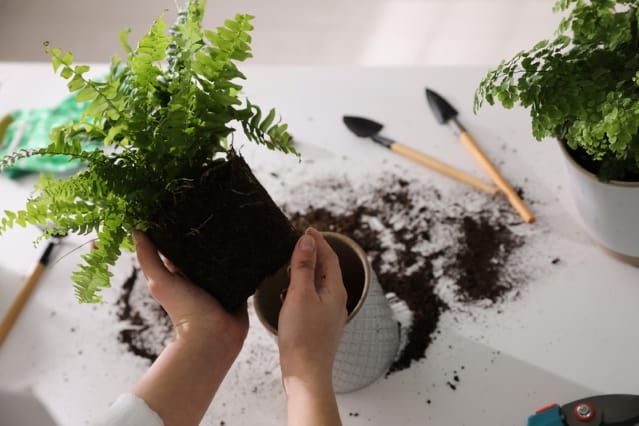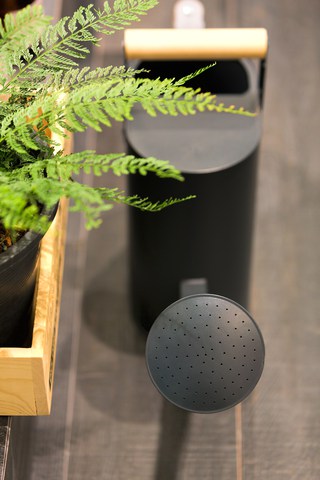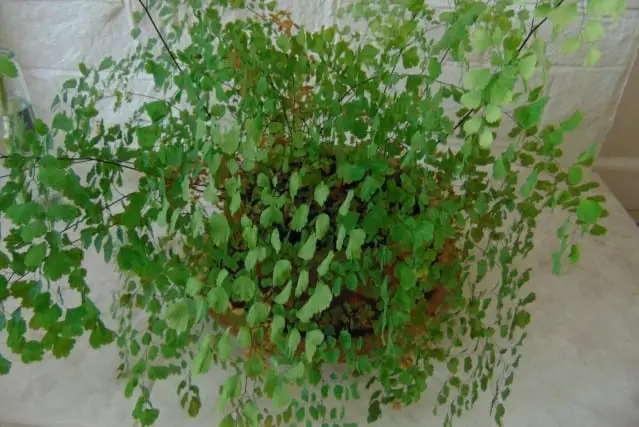As someone who can be a bit haphazard about keeping to watering schedules, I’m grateful that ferns can be very forgiving plants. Most ferns thrive best in moist, humid environments, but so as long as you do not let them dry out completely, they can usually handle occasional floods and droughts.
As a general rule, too little water is more damaging to ferns than too much, but overwatering is a danger and can cause serious harm. The worst risk is rot that destroys the roots and kills the plant, but overwatering can also cause less serious problems, like wilting, unpleasant smells and yellowing fronds.
Fortunately, there are some easy fixes that can repair the damage of overwatering and help maintain the correct level of hydration in the future. Here are some simple steps to take if you are worried that you have been overwatering your fern:
1. Check for the key signs of overwatering
There are several indicators that your fern has been overwatered. The first is simple – if the soil is slimy or soggy then it is likely to be waterlogged. Another simple indicator is the pot is heavy when lifted, suggesting that a lot of water has been absorbed and retained. Similarly, standing water in the tray beneath the pot is another obvious sign of overwatering.
Another clue is unpleasant smells. If the fern smells musty, or even worse, like rotten eggs, it could be a sign of overwatering leading to growth of bacteria or fungus in the soil.
Finally, there are some clues from the status of the fern itself. If the soil is damp, but the fern is wilting, then it is not lack of water that is the problem, it is too much. If this continues for some time, the fronds can turn a sickly yellow – another indication that the fern is suffering from overenthusiastic watering.
2. Check for root rot
Once you have established that the fern has been overwatered, the next stage is to assess how severe the damage is. The main danger is root rot, where bacteria can grow in the excessively damp conditions and attack the delicate root system of the fern, jeopardizing its survival.
To check for root rot, carefully remove the fern from the pot, and examine the roots.

If they have turned black, look soggy, and are mushy to the touch, they are rotten. Similarly, the sniff test should let you know if rot is severe, as the root ball will smell like rotten eggs.
To deal with root rot, cut away the rotten roots with clean pruning shears or scissors, down to healthy roots. Then rinse the root ball in clean water. It is not worth trying to save the original potting mix, which is infected, so replanting in fresh compost is recommended (see step 4).
3. Fix the overwatering without hurting the fern
If you find instead that your fern is free of root rot, you still need to deal with the problem of too much water. The best way to do this is to wrap the sodden root ball in a couple of sheets of newspaper, or an old towel (that you don’t mind getting dirty!).
Do your best to wrap the root ball well, using elastic bands or tape if necessary. Then, slide this package into a (slightly larger) pot which is lined with more newspaper, toilet or kitchen paper, or another towel, with the fern standing upright as though it was still in its pot.
This simple arrangement allows the water to be drawn out of the soil without it collapsing or drying out the roots too thoroughly, which could destroy them.
Leave for a few hours, or overnight, and then carefully unwrap the package again. You can return the fern to its original pot at this stage, with maybe a little extra potting mix to fill any air gaps.
4. Pick a soil mix that reduces waterlogging
One possible cause of a fern becoming waterlogged is that standard multipurpose compost or potting mix can be quite slow to drain. The way around this is to supplement the compost with some coarse materials – such as vermiculite, perlite, coarse sand or grit.
These additions will help to aerate the soil, and stop it clumping and absorbing so much water, as well as increasing the speed of draining.
Another sensible step is to use an absorbent pot material, with terracota being the obvious choice. Plastic or glazed pots will trap water within the interior, and not allow the soil to “breathe”. Terracota will absorb excess water, and allow it to evaporate out through the sides of the pot as well as draining the bottom. In fact, terracota can be a useful in itself for spotting overwatering, if the base of the pot has damp patches or is obviously soaked.
Ensuring your pots have a drainage hole in the base is another important consideration, and checking that after watering, the tray beneath the pot does not become so full with standing water that the soil above cannot drain further and instead becomes drenched.
5. Use tools that help with watering
Finally, it is possible to help protect against future overwatering by using some tools to help keep on top of the watering schedule. First up, you can stand the pot on a pebble tray. This has two big advantages – it prevents the pot from sitting directly in water, and it provides some humidity that will benefit the fern as the water around the pebbles evaporates up into the overhanging fronds.
Another useful tool is a slow release watering system of some sort. Perhaps the simplest tool is a rose on the end of the watering can, to ensure that you shower rather than drown the fern.

There are many other products that are slightly more sophisticated, and can control the release of water in response to the actual state of the soil. A good example is a hydrostick. This is a porous spike that can be pushed into the soil, which has a capillary line attached that can be submerged into a bottle of water. As the soil naturally dries out, the water will leach out of the hydrostick and replace it, but with no risk of flooding the pot and overwatering.
Other similar products include self-watering pots, and various other bulbs, drip-feed reservoirs and – at the high end – electronic pumps and programmable watering systems. For the busy or forgetful gardener, there are lots of ways to help protect your plants against the risks of intermittent or overenthusiastic watering.
Finally, if you are particularly prone to drowning your plants with kindness, a last option is to pick a fern that can thrive in damp conditions. Some varieties are well suited to wet soil, including some of the most popular indoor varieties. Boston ferns and maidenhair ferns are very forgiving, but even these stalwarts can suffer if they are waterlogged for too long.

Boston fern
- Nephrolepis exaltata
- Evergreen
- Partial shade
- Height: up to 1 m
- Soil: acid or neutral. Moist, well-drained.

Maidenhair fern
- Adiantum raddianum
- Evergreen
- Partial shade
- Height: up to 0.5 m
- Soil: neutral or alkaline. Moist, well-drained.
It is possible to overwater ferns, even though they are some of the more water-tolerant houseplants. However, with these simple steps, the risks can be reduced to a minimum and you can enjoy healthy and vibrant plants free from odors and wilting in the long term.
